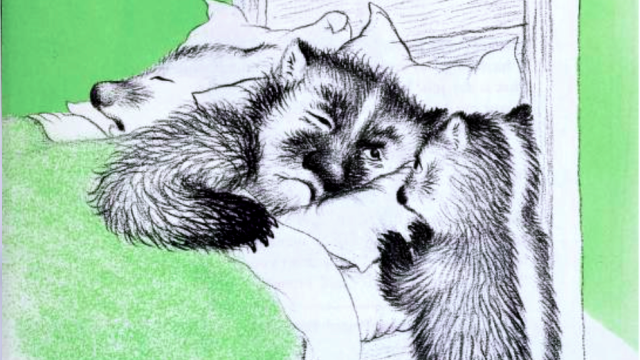There might never be a better book written about nighttime struggles than Bedtime for Frances. That it arrived so early in the golden age of children’s books (usually identified with the rise of Dr. Seuss) is a little bit of a surprise, but generations have grown up with this spunky badger and her loving family.
There’s a reason for that: Ursula Nordstrom.
After joining the company as a clerk in 1936, Nordstrom worked her way up to be Harper & Row’s first female vice president in 1960, and even before that, she’d made a permanent impact on children’s books. Editing Bedtime for Frances was part of an illustrious career that included Newbery and Caldecott award winners and other classics still read today. She was a champion of what she called “good books for bad children,” including what might have been the first American book published for teenagers, the first children’s book to address menstruation, and the first young adult book to address same-sex attraction. (Nordstrom herself was a lesbian, or queer, or…well, I couldn’t find exactly how she identified in the time I had to research this piece, and she may never have said anyway, but she had plenty of relationships with women and none to my knowledge with men.) Nordstrom liked the kids who fought back (literally, in Where the Wild Things Are, another book she edited and championed), the kids who couldn’t fit in (like Harriet the Spy), and even little bunnies who threaten to run away (yes, The Runaway Bunny).
The characters in the books Vernon championed feel real and multi-dimensional, as a result of this willingness to show the rough edges of childhood. You can picture them having busy days, getting frustrated at lunchtime, going to school. And going to bed.
Not, you’ll note, going to sleep, just going to bed.
Frances is supposed to be off to bed, but things are just not right. She needs kisses, and reassurance, and of course, a glass of milk. Going to bed is a lot of work when you’re a child…or a parent.
One of the reasons that Bedtime for Frances has endured, I think, is that when you read it as an adult. it feels as familiar to your experiences as it did when you were small, especially if you have tried to wrangle a child into bed. Frances’ parents take the interruptions with good grace, but you can tell that they would like Frances to stop making excuses and just, as a much later children’s book would phrase it,* “go the fuck to sleep.” No wonder generations of parents loved reading this story to their children.
Frances is a plucky heroine, easy to identify with if you’re a child and easy to love if you’re a parent. She just does not want to go to bed and is willing to pull out every single stop to avoid it. And, like most children her age, the line between what Frances sincerely believes and what she wants to believe to stay out of bed is a bit blurry.
Bedtime for Frances captures that childhood space perfectly. Her parents are indulgent, to a point, and their love is clear even when we can see they’ve become frustrated.
Bedtime for Frances, and Frances herself, feels like the ancestor of Calvin, Harriet M. Welsch, and lots of other daydreaming, clever protagonists who are as endearing as they are frustrating. She stands out in particular for being one of the rare girls in this early era of children’s fiction allowed to be difficult and imaginative.
Garth Williams’ illustrations are perfectly suited to the story; simple line art with gentle ink washes, soothing but still containing plenty of personality. Shadows are just menacing enough, and the fur of Frances and her badger family looks soft and warm. Frances’ family home is comforting and simple. It’s no surprise that Frances spurred many sequels (which would be illustrated by author Russell Hoban’s wife Lillian, in the same lovely style, though Lillian is credited with giving Frances more expression and more authentic body language). This is a home a reader is glad to revisit, again and again.
Through all five sequels, Frances remained — remains to this day — a little badger girl that almost any child would want to be friends with. Hoban would later author Emmet Otter’s Jug-Band Christmas, also illustrated by Lillian, which was adapted by Jim Henson into an enduringly charming Christmas special (with, yes, a legendary set of outtakes). He also wrote dozens of books for children and more than a dozen adult novels; I think it’s safe to say that he knew a lot about imagination at any age. (He was also an illustrator but didn’t think his style was warm or fuzzy enough for Frances.) Lillian would illustrate many of Harper & Row’s “I Can Read” series for beginning readers. Williams also had a storied career, including the original illustrations for Charlotte’s Web.
Ursula Nordstrom stepped down as publisher in 1976 but continued as a senior editor with her own imprint until 1979. She was succeeded by one of her own protégés, Charlotte Zolotow, who also wrote children’s books of her own, several of which Nordstrom edited. Her impact can be seen not just in children’s literature, but in the work of countless writers and editors who grew up on her books.
* Go the Fuck to Sleep is, of course, a parody that riffs on Margaret Wise Brown (among others), one of the many writers edited by Nordstrom.
Kirkus Reviews has their original review of Frances online. They liked it.
For more on the queer authors and creators, many of whom were edited by Nordstrom, who pioneered modern children’s lit, this article in the LA Review of Books is a good start.


